Optimal verification of stabilizer states
Ninnat Dangniam, Yun-guang Han, Huangjun Zhu
10 Aug 2020
Department of Physics and Center for Field Theory and Particle Physics, Fudan University




Identitifying a quantum state

Trusted multi-qubit measurement
- Quantum state tomography fully identifies an unknown quantum state
- Sample-optimal tomography requires an exponential amount of resource (Haah et al., 2017), entangled measurements (serial or parallel)



i.i.d. quantum states
\(\sigma^{\otimes N}\) (possibly mixed)
State space
Verifying a quantum state




Trusted single-qubit measurement



\(O_A \otimes I_B + I_A\otimes O_B \longrightarrow O_A \otimes O_B\)
classical post-processing
i.i.d. quantum states
\(\sigma^{\otimes N}\) (possibly mixed)
- Quantum state verification aims to certify that \(\sigma\) is close to some target pure state \(\rho\) using only local projective measurements
State space
\(XX\)
(relative
phase)
\(ZZ\)
(parity)
| +1 | +1 |
| -1 | +1 |
| +1 | -1 |
| -1 | -1 |
For general pure states (linear combinations of the four Bell states) and mixed states, there will be a failure probability to detect the target state
Example: Distinguishing Bell states
(\(|\Phi^+\rangle\langle\Phi^+|\) is nonlocal)
Measure \(\{\Pi_j, I-\Pi_j\}\) with probability \(p_j\)
Obtain
\(\Pi_j\)

Obtain
\(I-\Pi_j\)
Reject
The hypothesis testing scenario
Chernoff-Stein lemma
\(\sigma=\rho\): Accept with probability 1
(No type I error)
\(\epsilon\)-far: Accept with probability \(\delta\) (type II error)
\(|\psi\rangle\) is a +1 eigenstate of the verification operator
spectral gap \(\nu(\Omega)\)
Pallister et al., PRL 120 170502 (2018)
Zhu & Hayashi, PR Appl. 12, 054047 (2019)
Test projector
Existing results
| Efficient? | Optimal? | |
|---|---|---|
| Bipartite pure states | ||
| GHZ | ||
| Hypergraphs | * | |
| (Phased) Dicke states | ||
| Antisymmetric basis states | ||
| Stabilizer states | ? |







Pallister et al., PRL 120 170502 (2018)
Our work

Main results for this talk
- There is an efficiency bound for verification of stabilizer states that does not depend on the number of qubits or the specific stabilizer states
- The bound can be saturated, at least up to seven qubits, by explicitly constructing an optimal measurement scheme
Stabilizer and graph states
Stabilizer states
Efficiently describable states
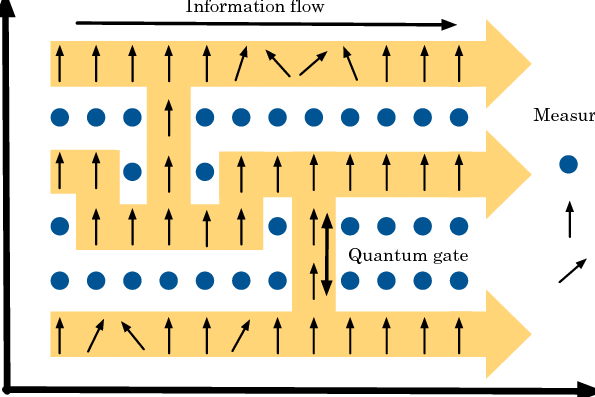
Cluster states
- Resource states for MBQC
GHZ state
- Quantum error correction
- Secret sharing

- Every stabilizer state is LU-equivalent to some graph state
- Stabilizer state = stabilized by a commuting subgroup of the \(n\)-qubit Pauli group
\(\mathcal{P}_n = \{\pm 1,\pm i\}\cdot\{I,X,Y,Z \}^{\otimes n}\)
that does not contain \(-I\), called a stabilizer group \(\mathcal{S}\)
- Completely speficified by \(n\) independent generators of the group

Graph states
Every convex combination of stabilizers in \(\mathcal{S}\) of a target stabilizer state \(|\psi\rangle\) has \(|\psi\rangle\) as a +1 eigenstate, but not all of them are measurable locally
Characterizing test projectors
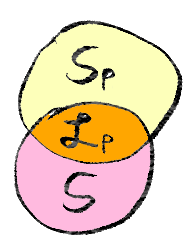
\(\mathcal{S}_P\) = stabilizer group generated by all single-qubit Pauli operators that constitute a Pauli measurement
Local subgroup
Example: GHZ state
| XXXX... |
| ZZI... |
| IZZI... |
| IIZZI... |
Measuring ZZ... effectly measures half of the stabilizer group
Canonical test projector
Verification of stabilizer states
Unique optimal strategy if restricted to stabilizer measurements: measuring all stabilizers with equal probabilities
More general measurements?
Pallister, Linden and Montanaro, PRL 120 170502 (2018)
Wang and Hayashi, arXiv:1901.09467 [quant-ph]
(2/3 when \(n=2\))
- Increasing the dimension of one half of a maximally entangled bipartite system cannot increase \(\nu(\Omega) = 2/3\)
- But every stabilizer state is maximally entangled w.r.t. any \((\mathcal{C}^2, (\mathcal{C}^2)^{\otimes n})\)-bipartition
Spectral gap is upper bounded by 2/3
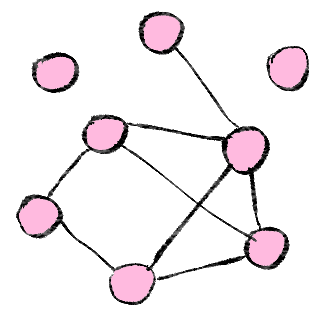
- Increasing the dimension of one half of a maximally entangled bipartite system cannot increase \(\nu(\Omega) = 2/3\)
- But every stabilizer state is maximally entangled w.r.t. any \((\mathcal{C}^2, (\mathcal{C}^2)^{\otimes n})\)-bipartition
Spectral gap is upper bounded by 2/3
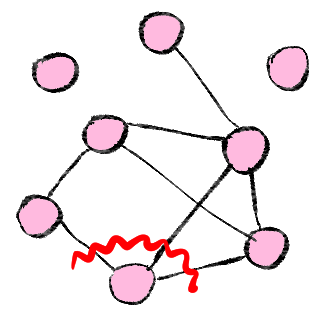
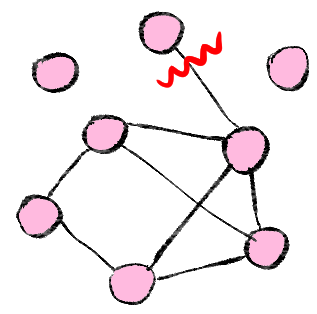
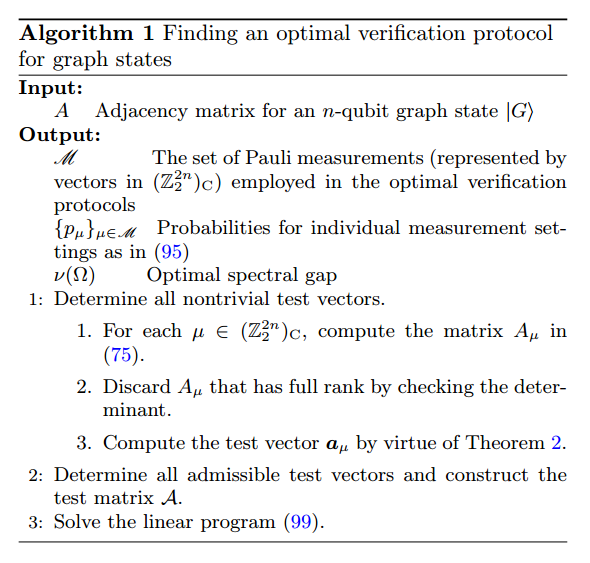
The algorithm
The bound can be saturated for all graph states up to seven qubits by explicitly constructing the optimal measurement scheme
- All computation is done in the symplectic vector formalism
- Construct the local stabilizer projector.
- Optimize the spectral gap (\(l_{\infty}\)-norm minimization - a linear program hence efficient)
- Do this for all 45 LU-equivalent classes of graph states (LC-equivalent to stabilizer states)
Hein, Eisert and Briegel, PRL 69 062311 (2004)
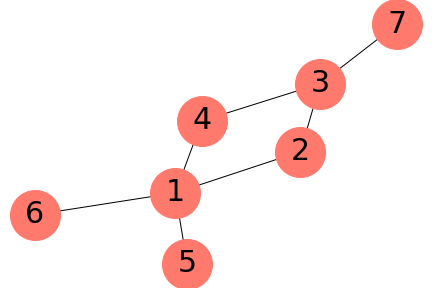
| Paulis | Probabilities |
|---|---|
| ZXZXXXX ZZYYXXZ ZYXZXXY XZZYZYX XZXZZZZ XXXXYZY XYYYYYY YZYZZYY YXYXZZZ YYZZYYX YYXYYZZ |
1/6 1/12 1/12 1/12 1/12 1/12 1/12 1/12 1/12 1/12 1/12 |
The algorithm
Other results
- Necessary condition for optimal verification by Pauli measurements \(p_x=p_y=p_z=1/3\)
- Optimal XZ strategies (\(\nu = 1/2\)), optimal strategy for odd ring states (simplest non 2-colorable graph)
- Admissible test projector = canonical test projectors that do not contain any other test projector, admissibility of XZ measurements \(\iff\) maximal independent set
- Minimal number of settings for verification
Equality for all graph states up to seven qubits
Stabilizer verification
By Ninnat Dangniam
Stabilizer verification
TeamNet group seminar, 10 Aug 2020
- 310



